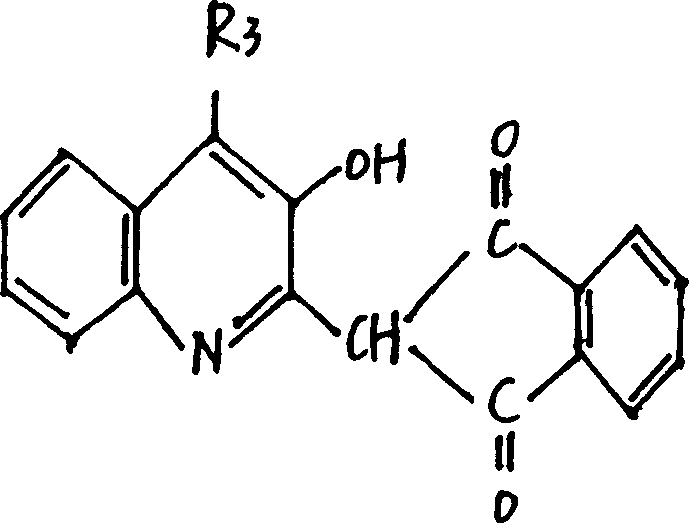Composite environment-friendly disperse dye
A disperse dye and composite technology, applied in the direction of organic dyes, can solve the problems of high dyeing production cost, poor compatibility, poor sublimation fastness, etc., achieve good sublimation fastness, high coloring rate, and reduce production costs Effect
- Summary
- Abstract
- Description
- Claims
- Application Information
AI Technical Summary
Problems solved by technology
Method used
Image
Examples
Embodiment 1
[0024] Mix 29 grams of dye monomer A, 92 grams of dye monomer B, 158 grams of dye monomer C, and 721 grams of sodium lignosulfonate, add 1500 grams of water, grind and disperse with a grinder, and then spray dry. About 1000 grams of finished product were obtained.
[0025] The above-mentioned sodium lignosulfonate can be replaced by an equivalent amount of naphthalenesulfonic acid formaldehyde condensate (NNO) or methylnaphthalenesulfonic acid formaldehyde condensate (MF) or benzylnaphthalenesulfonic acid formaldehyde condensate (CNF). Sodium lignosulfonate, naphthalenesulfonate formaldehyde condensate (NNO), methylnaphthalenesulfonate formaldehyde condensate (MF), benzylnaphthalenesulfonate formaldehyde condensate (CNF) any two or three or four mixture.
Embodiment 2
[0027] Mix 300 grams of dye monomer A, 9 grams of dye monomer B, 150 grams of dye monomer C, and 721 grams of sodium lignosulfonate, add 1500 grams of water, grind and disperse with a grinder, and then spray dry. About 1000 grams of finished product were obtained.
[0028] The above-mentioned sodium lignosulfonate can be replaced by an equivalent amount of naphthalenesulfonic acid formaldehyde condensate (NNO) or methylnaphthalenesulfonic acid formaldehyde condensate (MF) or benzylnaphthalenesulfonic acid formaldehyde condensate (CNF). Sodium lignosulfonate, naphthalenesulfonate formaldehyde condensate (NNO), methylnaphthalenesulfonate formaldehyde condensate (MF), benzylnaphthalenesulfonate formaldehyde condensate (CNF) any two or three or four mixture.
Embodiment 3
[0030] Mix 58 grams of dye monomer A, 37 grams of dye monomer B, 64 grams of dye monomer C, and 841 grams of sodium lignosulfonate, add 1500 grams of water, grind and disperse with a grinder, and then spray dry. About 1000 grams of finished product were obtained.
[0031] The above-mentioned sodium lignosulfonate can be replaced by an equivalent amount of naphthalenesulfonic acid formaldehyde condensate (NNO) or methylnaphthalenesulfonic acid formaldehyde condensate (MF) or benzylnaphthalenesulfonic acid formaldehyde condensate (CNF). Sodium lignosulfonate, naphthalenesulfonate formaldehyde condensate (NNO), methylnaphthalenesulfonate formaldehyde condensate (MF), benzylnaphthalenesulfonate formaldehyde condensate (CNF) any two or three or four mixture.
PUM
 Login to View More
Login to View More Abstract
Description
Claims
Application Information
 Login to View More
Login to View More - R&D
- Intellectual Property
- Life Sciences
- Materials
- Tech Scout
- Unparalleled Data Quality
- Higher Quality Content
- 60% Fewer Hallucinations
Browse by: Latest US Patents, China's latest patents, Technical Efficacy Thesaurus, Application Domain, Technology Topic, Popular Technical Reports.
© 2025 PatSnap. All rights reserved.Legal|Privacy policy|Modern Slavery Act Transparency Statement|Sitemap|About US| Contact US: help@patsnap.com



